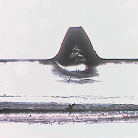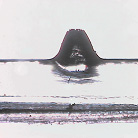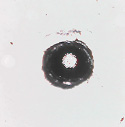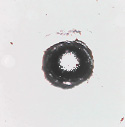(Part 4 of a 5 part series)
Maintaining the perfect dot is not easy, and to do so we must control several factors, one of which is knowing when the photopolymer plate has become worn to the point that it will have adverse effects on the printed product. But how open have you replaced costly photopolymer plates suspecting that the plate is worn, but still have a sinking feeling in your stomach that something else could be causing excess dot gain or a poor ink laydown? Here is a quick and easy way to determine plate wear specifically pertaining to process and/or screen plates.
Viewing the dots on a plate from above, we see two parts of the plate for certain. These two parts are is the face of the plate, and the plate shoulder. If the screen rule and dot percentage is such, we may also see the floor of the plate between dots. One thing is certain, plate wear occurs on the face of the plate and certainly not at the base of the dot where the shoulder meets the plate floor or overlaps the successive dots shoulder.
Because the profile of a dot looks similar to a trapezoid it is easy to understand how plate wear on the face of the plate can be benchmarked, measured, and compared over time to identify plate wear. As wear takes place the face of the plate or in this case the dot increases in size. A measurement of the diameter of the dot in the beginning stages of production can be compared with a measurement of the dot in later stages of production. If there has been an increase to the image area, dot gain can be expected, calculated and then controlled.
As the dot begins to wear and the diameter of dots increase, the shoulder width will decrease in a corresponding measurement because of the geometry of the plate profile. The shoulder of the plate plays a very important part in the printability of the printing plate. A steep shoulder (narrow shoulder) lacks the support needed to support the image area, and will lead to dots slurring. This defect is often seen in plates that have an inadequate main (face) exposure to UV light. Very broad shoulders can also have adverse effects on print by having fill-in or bridging between dots or image areas. Plates receiving an excessive main (face) exposure often produce this print defect. Therefore it is easy to understand that plate wear not only will increase image size, but will also affect the shoulders, which support the image and control dot circularity and slur.
As dot size increases with wear, shoulder width decreases. One devise that will measure these two plate characteristics is Quality Engineering Associates (QEA) Image Analysis System (Flexo IAS) that measures a many features of film negative, plate, and print. One of these plate-measuring features is the measurement of dot diameter and shoulder width.
Image A shows the profile of a new plate, while Image B illustrates a worn plate image. Image C shows a new plate image, while Image D illustrates a worn plate image.
Image A
Image B
Image C
Image D




